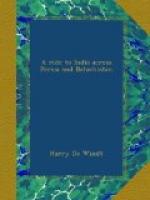His Highness Mir Khudadad, Khan of Kelat, is about sixty years old. He would be tall were it not for a decided stoop, which, together with a toothless lower jaw, gives him the appearance of being considerably more than his age. His complexion is very dark, even for a Baluch, and he wears a rusty black beard and moustaches, presumably dyed, from the streaks of red and white that run through them, and long, coarse pepper-and-salt locks streaming far below his shoulders. His personal appearance gave me anything but a favourable impression. The Khan has a scowling expression, keen, piercing black eyes, and a sharp hooked nose that reminded one forcibly of Cruikshank’s picture of Fagin the Jew in “Oliver Twist.”
The Khan was dressed in a long, loose, white garment, with red silk embroidery of beautiful workmanship. A thin white Cashmere shawl was thrown carelessly over his shoulders, and he wore a conical violet silk cap, trimmed with gold lace, and a pair of pointed green morocco slippers, turned up at the toes, and ornamented with the same material. A massive gold necklace, or collar, thickly studded with diamonds, rubies, and sapphires, hung round his neck. The stones, some of them of great size, were set indiscriminately without any regard to pattern or design. Mir Khudadad wore no other jewels, with the exception of three small torquoise rings, all worn on the little finger of the left hand. He carried no arms, but held in his right hand a large and very dirty pocket-handkerchief of a bright yellow hue with large red spots, which somewhat detracted from his regal appearance. The Khan is a great snuff-taker, and during the audience continually refreshed himself from the contents of a small gold box carried by his son. Prince Azim, who was dressed in a green silk jacket and loose magenta-coloured trousers, is a pleasant-mannered lad of about twenty. He is of much lighter complexion than his father and has a strong Jewish cast of feature. A huge cabochon emerald of great value, suspended from the neck, was Azim’s sole ornament.
[Illustration: PALACE OF THE KHAN. KELAT.]
A conversation now commenced, carried on through the medium of the Wazir and my interpreter. The Khan has a fidgety, uneasy manner that must be intensely exasperating to his court. More than once during the audience, having asked a question with much apparent earnestness, he would suddenly break in, in the middle of a reply, and hum a tune, or start off on a totally different subject from the one under discussion. At other times he would repeat a question twice or thrice, and, his eyes fixed on vacancy, utterly ignore the answers of the Wazir, who evidently stood in great awe of his eccentric sovereign. Though the following colloquy may appear brief to the reader, it took nearly an hour to get through.
“Where do you come from, and what are you?” was the Khan’s first question.
“From Russia, your Highness.”




